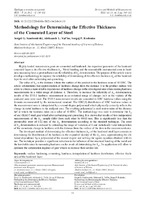Methodology for Determining the Effective Thickness of the Cemented Layer of Steel

Date
2023Publisher
Another Title
Методика определения эффективной толщины цементированного слоя стали
Bibliographic entry
Sergei, G. S. Methodology for Determining the Effective Thickness of the Cemented Layer of Steel = Методика определения эффективной толщины цементированного слоя стали / G. S. Sergei, L. V. Aleksandr, P. R. Sergej // Приборы и методы измерений. – 2023. – Т. 14, № 2. – С. 145-151.
Abstract
Highly loaded transmission gears are cemented and hardened. An important parameter of the hardened cemented layer is its effective thickness hef . Metal banding and the unavoidable instrumental error in hardness measuring have a great influence on the reliability of hef determination. The purpose of this article was to develop a methodology to improve the reliability of determining of the effective thickness hef of the hardened layer in steel after carburizing and quenching. The value of hef is the distance h from the surface of the product to the hardness zone of 50 HRC. The article substantiates that approximation of hardness change from the distance h to the product surface will allow to obtain a more reliable dependence of hardness change in the investigated area when making hardness measurements in a wider range of distance h. Therefore, to increase the reliability of hef determination, results of the HV0.5 hardness measurement in an extended range of changes in h in the vicinity of the analyzed zone were used. The HV0.5 measurement results are converted to HRC hardness values using the formula recommended by the international standard. The HRC(h) distribution of HRC hardness values in the measurement area is interpolated by a second-degree polynomial which physically correctly reflects the change in metal hardness in the analyzed area. The resulting polynomial is used to determine of the distance hef at which the hardness takes on a value of 50 HRC. The methodology was used to determine the hef of an 18KhGT steel gear wheel after carburizing and quenching. It is shown that results of two independent measurements of the hef sample differ from each other by 0.003 mm. This is significantly less than the permissible error of 0.02 mm of the hef determination according to the standard technique. The error of hef determination is reduced by extending the range of variation of h and statistically valid interpolation of the monotonic change in hardness with the distance from the surface of the item in the measurement area. The developed method of determining the effective thickness hef of the hardened steel layer consists in determining the distribution of its hardness in the expanded vicinity of the hef area, approximating the obtained dependence by a polynomial of the second degree and solving the square equation obtained with its use. The technique provides a significant reduction in the influence of the structural banding of the metal and the inevitable error in measuring hardness on the result of determining the hef . Its application will allow to optimize the cementation regimes of gear wheels to increase their service life.
Abstract in another language
Высоконагруженные зубчатые колёса трансмиссий подвергают цементации и закалке. Важным параметром упрочнённого цементированного слоя является его эффективная толщина hef . Большое влияние на достоверность определения hef оказывают полосчатость металла и неизбежная инструментальная погрешность измерения твёрдости. Цель работы – разработка методики повышения достоверности определения эффективной толщины hef упрочнённого слоя в стали после цементации и закалки. За величину hef принимают расстояние h от поверхности изделия до зоны с твёрдостью 50 HRC. В работе обосновано, что аппроксимация изменения твёрдости от расстояния h до поверхности изделия позволит получить более достоверную зависимость изменения твёрдости в исследуемой зоне при проведении измерений твёрдости в более широком диапазоне расстояний h. Поэтому для повышения достоверности определения hef использованы результаты измерения твёрдости HV0,5 в расширенном диапазоне изменений h в окрестности анализируемой зоны. Результаты измерения HV0,5 пересчитаны в значения твёрдости HRC по формуле, рекомендованной международным стандартом. Распределение HRC(h) значений твёрдости HRC в области измерения интерполировано полиномом второй степени, физически верно отражающим изменение твёрдости металла в анализируемой зоне. Полученный полином использован для определения расстояния hef , при котором твёрдость принимает значение 50 HRC. Методика использована для определения hef зубчатого колеса из стали 18ХГТ после цементации и закалки. Показано, что результаты двух независимых измерений hef образца отличаются друг от друга на 0,003 мм. Это существенно меньше допустимой погрешности 0,02 мм определения hef по стандартной методике. Погрешность определения hef снижена за счёт расширения диапазона изменения h и статистически обоснованной интерполяции монотонного изменения твёрдости с расстоянием от поверхности изделия в области измерения. Разработанная методика определения эффективной толщины hef упрочнённого слоя стали заключается в определении распределения её твёрдости в расширенной окрестности области hef , аппроксимации полученной зависимости полиномом второй степени и решении полученного с его использованием квадратного уравнения. Методика обеспечивает существенное снижение влияния структурной полосчатости металла и неизбежной погрешности измерения твёрдости на результат определения hef . Её применение позволит оптимизировать режимы цементации зубчатых колёс для повышения ресурса их эксплуатации.
View/
Collections
- Т. 14, № 2[7]
